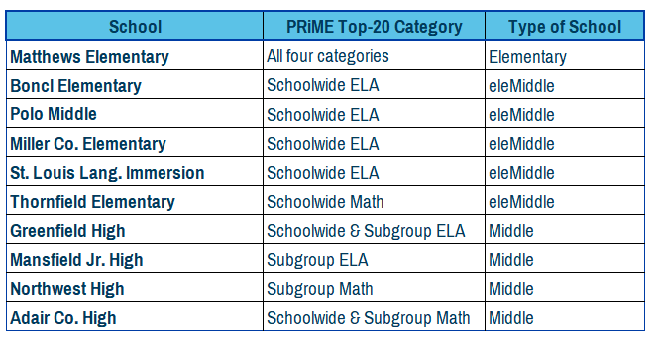Comparing 2019 and 2021 PRiME Growth Scores: Sustained Growth, Proficiency Declines
By: Mel Fenske
Published On: November 11, 2022
Photo by RODNAE Productions
Last week, the PRiME Center released the 2022 Missouri Statewide Student Growth Report, highlighting schools across the state with exceptional student growth in English Language Arts (ELA) and mathematics, both schoolwide and among the Subgroup (historically underserved students). Data from this report is also useful to contrast trends in student growth before and after the COVID-19 pandemic to begin to understand the effects on student learning in Missouri. In this blog post, we compare the findings of our 2021 Missouri Student Growth Report (2019 Student Growth Scores) with the most recent findings in our 2022 Student Growth Report (2021 Student Growth Scores). We find:
Forty-five schools earned spots on top-20 lists in both the 2021 and 2022 Growth Reports. This signals sustained growth across several school years, despite the challenges brought on by the COVID-19 pandemic.
Thirty-five of the 45 schools with top-20 PRiME Growth Scores in 2021 and 2022 decreased in their percentage of students scoring proficient and advanced on the MAP. While this appears contradictory for high-growth schools, these drops in proficiency are representative of the learning loss that occurred during the 2020-21 school year.
Ten schools appeared on PRiME top-20 student growth lists in 2021 and 2022, and also managed to increase the percentage of students scoring proficient or advanced on one or more sections of the MAP test. Despite the challenges brought on by the COVID-19 pandemic, the schools shown below stood out amongst their peers. We commend these schools for their outstanding efforts to move student learning forward in the midst of a national crisis.
While the drops in proficiency are worrisome, DESE data show a glimmer of hope. Rebounding, a term which refers to gains in achievement comparable to pre-pandemic trends, is evident in the 2021–22 school year. The percentage of students scoring proficient or advanced on the mathematics portion of the MAP increased from 35 to 39% in 2022. Though the ELA portion of the MAP did not reflect the same trend, we are hopeful that evidence of rebounding will be apparent next year in the 2023 Growth Report, which will include MAP data from the 2021-22 school year. Importantly, all of the high-growth schools highlighted in our reports are on a good path to closing the achievement gap brought on by the COVID-19 pandemic. These schools are great examples for other schools in Missouri in need of accelerating student growth.
To learn more about the importance of student growth and see the lists of top-growth schools in Missouri, click the link below.






This week in neighboring Illinois, a bill to ban cell phones from classrooms unanimously passed in the Senate. The bill, advocated for by Illinois’ Governor J.B. Pritzker, now moves to the House. If passed, they would join the more than 40% of states who have laws or policies restricting cell phone use in schools. Missouri has similar legislation in the works, and voters are in support.